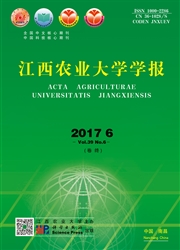

 中文摘要:
中文摘要:
以光敏核不育水稻N5088S为试验材料,研究了茉莉酸类与水稻育性的关系。研究结果表明,茉莉酸甲酯(Methyl jasmonate,MeJA)显著提高不育光温条件下光敏核不育水稻N5088S的花粉染色率和自交结实率,而其生物合成抑制剂水杨苷异羟肟酸(Salicyl hydroxamicacid,SHAM)则使可育光温条件下的N5088S花粉染色率和自交结实率显著降低;同时,MeJA提高了N5088S叶片和幼穗的脂氧合酶(LOX)活性,而SHAM则使其活性降低。在幼穗分化的第3—8期,N5088S叶片中的LOX活性在可育光温条件下明显高于不育光温条件,而幼穗中的差异不明显。这一结果说明外源MeJA可使不育光温条件下的光敏核不育水稻N5088S的育性在一定程度上得到恢复,并提示内源茉莉酸类(JAs)可能参与N5088S的育性转换。
 英文摘要:
英文摘要:
A study on the relationship between jasmonates and rice fertility was conducted in photoperiod -sensitive genic male -sterility (PSGMS) rice N5088S. The results showed that methyl jasmonate (MeJA) significantly increased fertile pollen rate and self-fertilized seed setting rate in natural sterile condition, and salicylhydroxamic (SHAM) decreased fertile pollen rate and self-fertilized seed setting rate in natural fertile condition. At the same time, MeJA increased lipoxgenase (LOX) activity in leaf and young panicle of N5088S, and SHAM had an opposite effect on the enzyme. From stage 3 to stage 8 of the panicle differentiation stages, LOX activity of the leaves in fertile condition was significantly higher than that in sterile condition, but no significant difference was detected in the young panicle. The results indicated that MeJA had an effect to restore the fertility of N5088S under natural sterile conditions, implying a role of JAs in the fertility development of PSGMS rice.
 同期刊论文项目
同期刊论文项目
 同项目期刊论文
同项目期刊论文
 期刊信息
期刊信息
